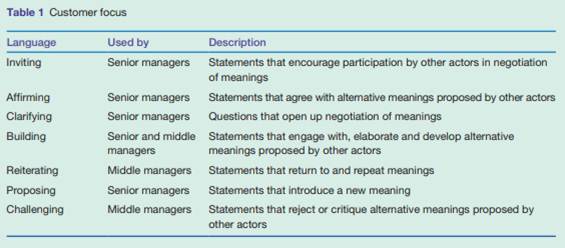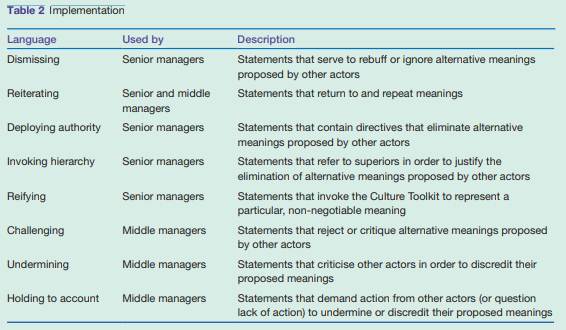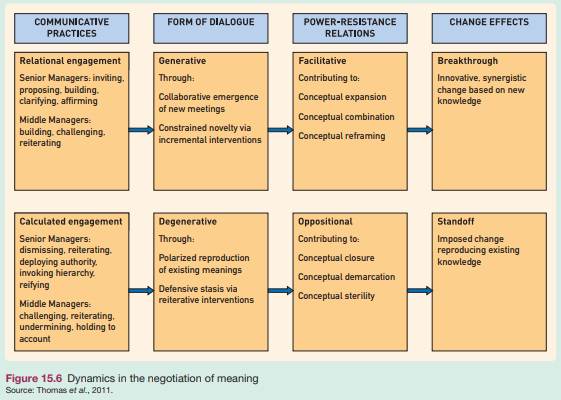The premise of and process for culture change at UTEL UTel1 licenses technologies to makers of mobile phones and other mobile communication devices. It employs 1,500 employees, mostly at its European head office. The company was formed in 2001, when it was ‘spun off’ from being a division of GlobalTel. This led to a change in its customer base; moving from a focus on serving individual end-users of phones, towards serving other companies who manufacture and sell phones. As a consequence, the company required a change in culture to support its new mission ‘to make our customers first, best and profitable through innovation, quality and commitment’. Senior management, together with external consultants, devised a cultural change programme premised on a three-hour workshop to be rolled out 80 times across the company, using the same format. The workshops were organised around a ‘Culture Toolkit’ that aimed to support the attainment of the company’s mission statement, and the development of a more customer-focused culture. The toolkit consisted of a brochure, a video and a set of instructions for conducting the workshops. The brochure was entitled ‘UTel’s Target Culture: Involving Every Employee’.
The video took the form of a 10-minute question and answer session between the CEO and another senior manager. It explained why the new culture was needed and provided information on the drivers and values underpinning it. In the video the CEO states that ‘next step [in the implementation of the change] is to involve everybody’. This was to happen through half-day workshops involving: (a) a presentation of the target culture, using the brochure and accompanying video; (b) a discussion of the relevance of the new culture to the particular group attending the workshop; and (c) exercises to build agreement on actions to be taken to implement the new culture. The aim was to secure involvement and input from employees and to bring about agreement on what the nature of the new culture should be and how it should be implemented across the company.
An overview of the workshop The initial workshop, observed by the researchers and forming the basis of this case, was attended by three head office managers, two senior managers, managers from supporting functions such as Human Resources and Finance, and circa 30 middle managers, including software and hardware engineers (who are mainly male). Middle managers who attended the workshop were to take the toolkit back to their own units and use it ‘to discuss how the new culture will affect their team, themselves as individuals, and Utel’. A senior manager opened the event, welcomed participants and gave them information about the workshop’s structure and goals. Another senior manager delivered a PowerPoint presentation describing his interpretation of the strengths and weaknesses of the local culture. This was followed by a general discussion about whether this interpretation was accurate. After a coffee break, the group considered the mission statement specified in the brochure. The video was then shown. Participants completed a ‘stop/start/continue’ exercise to identify one behaviour that was hindering cultural change and needed to be stopped, one new behaviour that needed to be started, and one existing behaviour that should be continued, the results of which were collected by the head office managers. The workshop concluded with a discussion of how to implement the change programme. Two core themes emerged during the workshop: the meaning of ‘a customer focus’ and discussion of how the implementation of the change process should progress.
The communicative practices and forms of language used in the two discussions were quite different, despite being part of the same workshop. Constructive communicative practices: theme 1, from a customer to a commercial focus The meaning of having a ‘customer focus’, broadly described in the Culture Toolkit, was discussed by participants as they worked through the exercises, referred to the brochure and reflected on the video. At the start of the workshop, a senior manager emphasised the need to achieve a ‘common understanding’ of having a customer focus. A head office manager then put forward a number of suggestions about how this might be defined and understood. Another senior manager then asked who is the customer (the end user or another business)? One of the software engineers then challenged the assumption that the UK site is not already customer focused. He asserted: I believe that we are customer-oriented. I think we are customer focused as an organisation and we have been all the way through, even in our history. I think we’re a customer-focused organisation. Discussion transitioned between whether or not the site was customer focused, who was the customer, and the nature of the relationships.
Later, the importance of a customer focus was challenged at a more fundamental level as one of the support staff argued that there was a need for a commercial focus: We are very driven by engineers and the technology . . . people do get caught up with developing incredible products that are fantastic with loads of features but from a commercial focus aren’t really needed . . . as an organisation we’re not necessarily as commercially and business focused as we need to be. (Manager, support staff) This comment was followed by a long silence, and then a challenge by an engineer who suggested that sales and marketing staff were responsible for the customer, before discussion returned to the need for a customer focus. After iterative debate, and a return to the video, the stop/start/continue exercise was conducted and a need for a commercial focus re-emerged, initiated by support staff managers and upheld by engineers. By the end of the discussion the group agreed that a customer focus was less important than a commercial focus. They developed a gradual consensus, defining a commercial focus as being financially aware and helping the company to be profitable. The emergence of the need for a commercial focus was premised on participants using communicative practices and forms of language to engage with each other in negotiating meaning. These included inviting, proposing, building, clarifying and affirming on the part of senior managers and building, challenging and reiterating on the part of middle managers (see Table 1). Constraining communicative practices: theme 2, implementation The workshop participants also discussed and negotiated the meaning of implementation.
These negotiations were much more polarised, with two parallel, separate discussions taking place: one involving senior managers and the other involving middle managers, with little evidence of engagement between them. Despite a head office manager initially encouraging the middle managers to identify the actions required for implementation, subsequent contributions by senior managers were all attempts to fix the meaning of implementation around their predetermined programme. Senior managers defined implementation in terms of the continuation of the workshops to create awareness of the existing culture, with further specific implementation activities to be decided by head office. In contrast, engineers and support staff tried to fix the meaning of implementation in terms of local actions,

which required ‘clear direction’, ‘road maps’ and ‘timelines’. Senior managers used communicative practices and forms of language premised on dismissing, reiterating, deploying authority, invoking hierarchy, and reification, especially towards the end of the workshop. Middle managers attempted to resist senior management’s meaning through challenging, reiterating, holding to account and undermining (see Table 2). However, rather than build on the alternative meanings of implementation proposed by middle managers, senior managers continually reinforced their preferred meaning. For example, a headquarters manager held up a copy of the brochure and, referring to the video and the exercise templates in the Culture Toolkit, shouted at all the middle managers: You should have . . . the video . . . I will email you the slides that we presented today [and] the agenda for the three-hour meeting that you’ll have with your staff; going through the stop start in the workshops, that’ll be in your slides; instructions on how to run the discussions; and also the template for the stop start workshops. The templates that we want you to work on are template two and template four, those two templates once you’ve conducted the workshops with your staff. I need them in by the end of August. At the end of August I will send all my information to [head office] who will make a presentation to [the CEO].
It matters what you say and how you say it: theme 3, language, power, resistance and change The communicative practices and forms of language in the discussions around customer focus produced a relational engagement, where both parties took active responsibility for the joint tasks in which they were involved. This, in turn, helped to produce generative dialogue, which enabled new meanings to emerge collaboratively, insofar as a range of middle and senior managers contributed to identifying the need for a commercial focus, which was not part of the original change initiative. The dialogue was also characterised by constrained novelty as participants made small modifications at each dialogue turn. Interventions followed from the initial meaning of customer focus but, at the same time, helped to construct another meaning (i.e. the need for a commercial focus), which was both novel – different to the original meaning – and familiar in that it emerged incrementally by building on what went before. Power–resistance relations were facilitative insofar as middle managers engaged in communicative practices that might be construed as ‘resistance to change’ in that they challenged senior managers’ meanings. However, it was this resistance that led to the emergence of the need for a commercial focus, i.e. it was the willingness of middle and senior managers to engage with each other, which gave rise to conceptual expansion, combination and reframing. From these

facilitative power–resistance relations came a breakthrough in the form of new knowledge about the need for the creation of a commercial focus – and not just a customer focus – as part of the change programme. In contrast, the discussion around implementation was associated with calculated engagement and degenerative dialogue, with polarised reproduction of two sharply contrasting meanings of implementation. Here, there was evidence of a defensive standoff with both senior and middle managers reiterating their preferred meanings time and time again as they take their turn in the dialogue. These power–resistance relations were oppositional – with a process that might be described as conceptual closure. With neither side willing to engage in the communicative practice of building, there was no way to bring the two meanings together or to use one to inform the other. Conceptual sterility arose with the dialogue losing momentum as senior managers engaged increasingly in coercive communicative practices. The number of interventions by middle managers started to decline around the two-hour mark. The result was a standoff as both sides steadfastly refused to acknowledge each other’s ideas concerning implementation. See Figure 15.6 for a comparison of the two forms of resistance.

Questions
1 What are the practical implications arising from the forms of dialogue evident in this case?
2 Under what circumstances, if any, might it be appropriate to use communicative practices and forms of language to constrain employees’ influence on change processes?
3 What, if anything, should have been done differently? Why?

